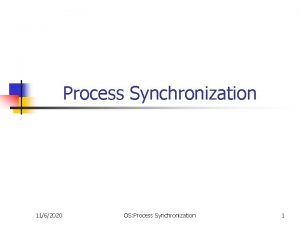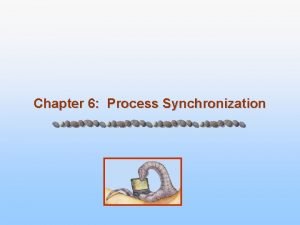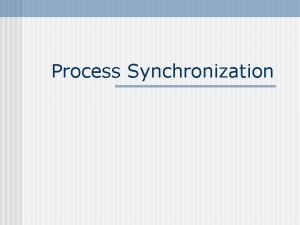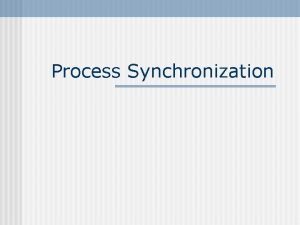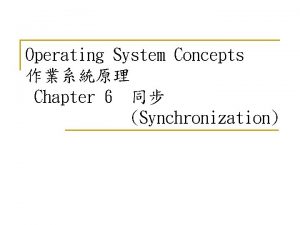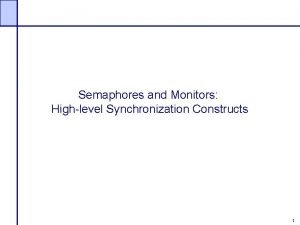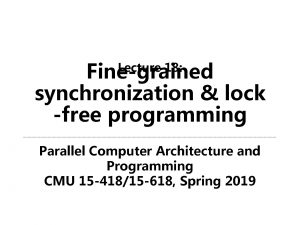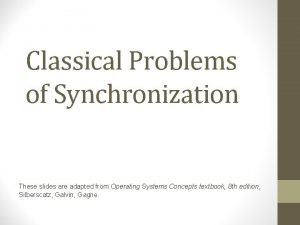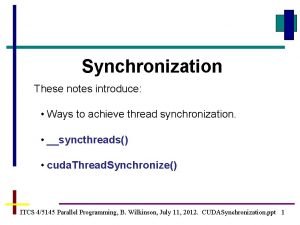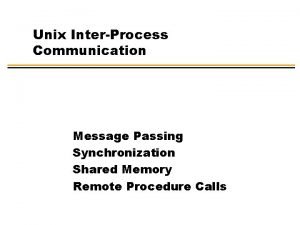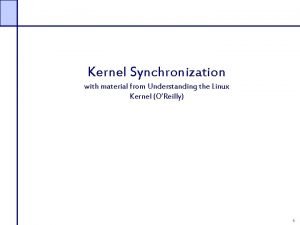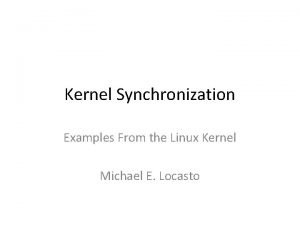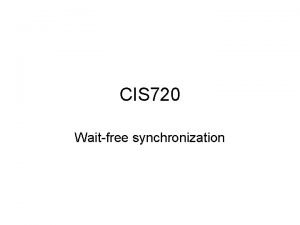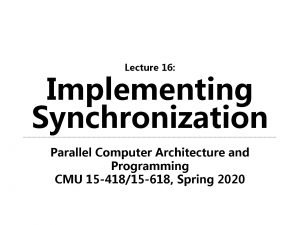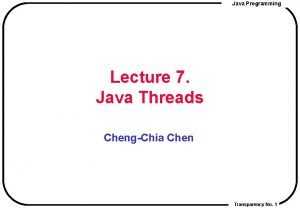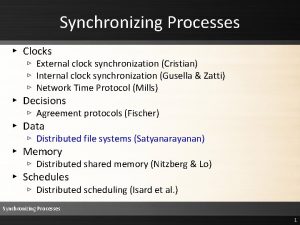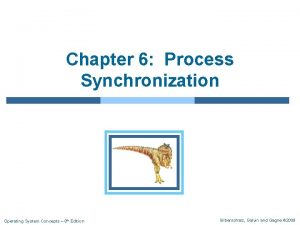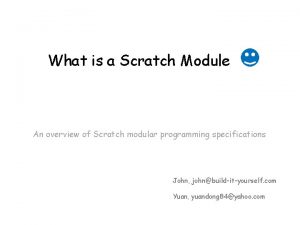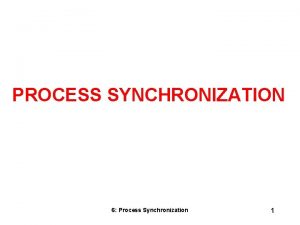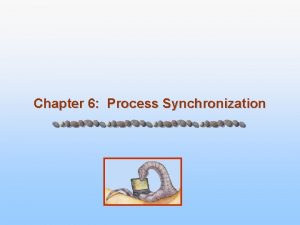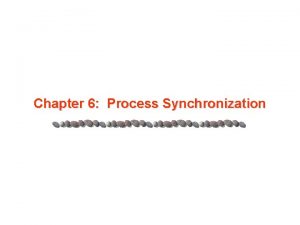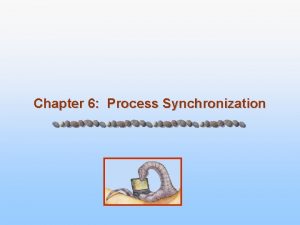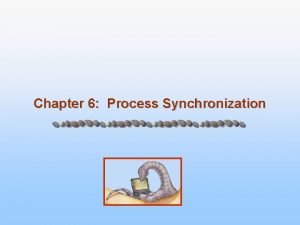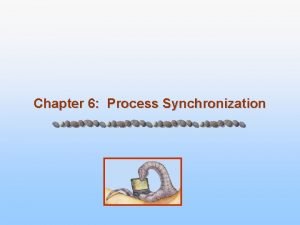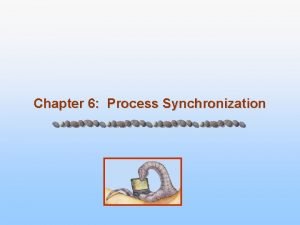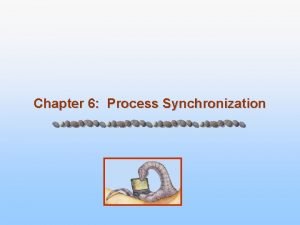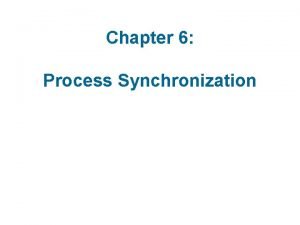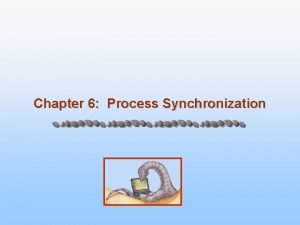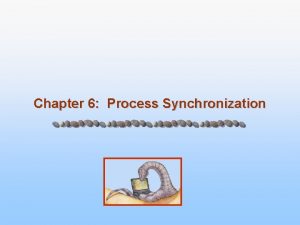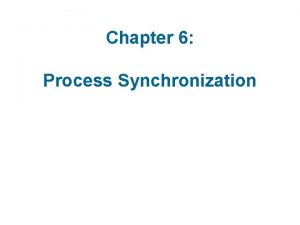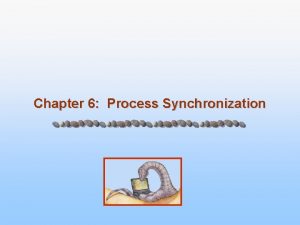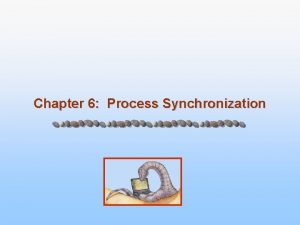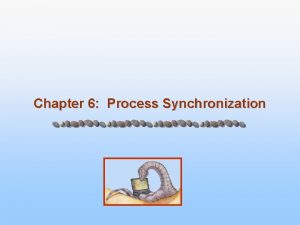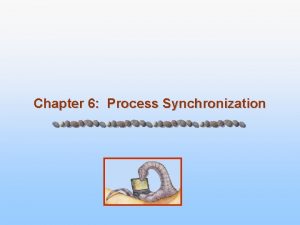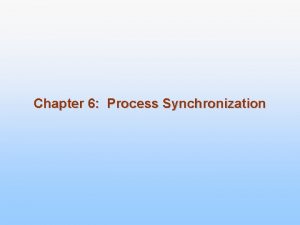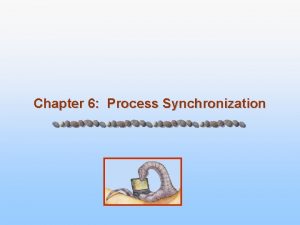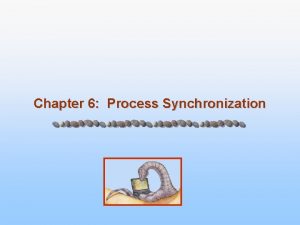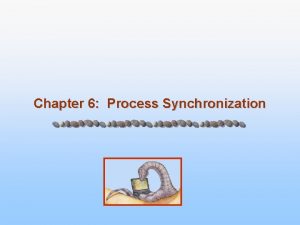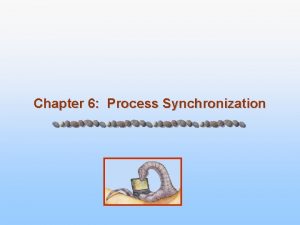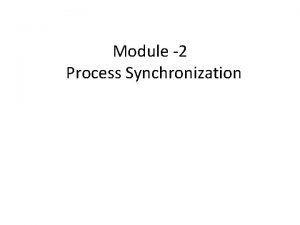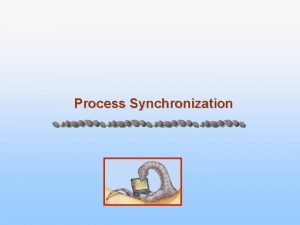Chapter 6 Process Synchronization Module 6 Process Synchronization










































![Solution to Dining Philosophers monitor DP { enum { THINKING; HUNGRY, EATING) state [5] Solution to Dining Philosophers monitor DP { enum { THINKING; HUNGRY, EATING) state [5]](https://slidetodoc.com/presentation_image_h2/3c7bd2f38434c93e28c01cc3d2ad183a/image-43.jpg)







- Slides: 50

Chapter 6: Process Synchronization

Module 6: Process Synchronization n n n Background The Critical-Section Problem Peterson’s Solution Synchronization Hardware Semaphores Classic Problems of Synchronization Monitors Operating System Concepts – 7 th Edition, Feb 8, 2005 6. 2 Silberschatz, Galvin and Gagne © 2005

Background n Concurrent access to shared data may result in data inconsistency n Maintaining data consistency requires mechanisms to ensure the orderly execution of cooperating processes n Suppose that we wanted to provide a solution to the consumer-producer problem that fills all the buffers. We can do so by having an integer count that keeps track of the number of full buffers. Initially, count is set to 0. It is incremented by the producer after it produces a new buffer and is decremented by the consumer after it consumes a buffer. Operating System Concepts – 7 th Edition, Feb 8, 2005 6. 3 Silberschatz, Galvin and Gagne © 2005

Producer while (true) { /* produce an item and put in next. Produced */ while (count == BUFFER_SIZE) ; // do nothing buffer [in] = next. Produced; in = (in + 1) % BUFFER_SIZE; count++; } Operating System Concepts – 7 th Edition, Feb 8, 2005 6. 4 Silberschatz, Galvin and Gagne © 2005

Consumer while (true) { while (count == 0) ; // do nothing next. Consumed = buffer[out]; out = (out + 1) % BUFFER_SIZE; count--; /* consume the item in next. Consumed } Operating System Concepts – 7 th Edition, Feb 8, 2005 6. 5 Silberschatz, Galvin and Gagne © 2005

Race Condition n count++ could be implemented as register 1 = count register 1 = register 1 + 1 count = register 1 n count-- could be implemented as register 2 = count register 2 = register 2 - 1 count = register 2 n Consider this execution interleaving with “count = 5” initially: T 0: producer execute register 1 = count {register 1 = 5} T 1: producer execute register 1 = register 1 + 1 {register 1 = 6} T 2: consumer execute register 2 = count {register 2 = 5} T 3: consumer execute register 2 = register 2 - 1 {register 2 = 4} T 4: producer execute count = register 1 {count = 6 } T 5: consumer execute count = register 2 {count = 4} Operating System Concepts – 7 th Edition, Feb 8, 2005 6. 6 Silberschatz, Galvin and Gagne © 2005

The Critical-Section Problem Critical section is a segment of code where the process may change Common variables, tables, files and so on. Operating System Concepts – 7 th Edition, Feb 8, 2005 6. 7 Silberschatz, Galvin and Gagne © 2005

The Critical-Section Problem 1. Mutual Exclusion - If process Pi is executing in its critical section, then no other processes can be executing in their critical sections 2. Progress - If no process is executing in its critical section and there exist some processes that wish to enter their critical section, then the selection of the processes that will enter the critical section next cannot be postponed indefinitely 3. Bounded Waiting - A bound must exist on the number of times that other processes are allowed to enter their critical sections after a process has made a request to enter its critical section and before that request is granted Operating System Concepts – 7 th Edition, Feb 8, 2005 6. 8 Silberschatz, Galvin and Gagne © 2005

Two-process solutions Algorithm 1: Operating System Concepts – 7 th Edition, Feb 8, 2005 6. 9 Silberschatz, Galvin and Gagne © 2005

Two-process solutions Algorithm 2: Operating System Concepts – 7 th Edition, Feb 8, 2005 6. 10 Silberschatz, Galvin and Gagne © 2005

Two-process solutions Algorithm 3: Operating System Concepts – 7 th Edition, Feb 8, 2005 6. 11 Silberschatz, Galvin and Gagne © 2005

Multiple process solutions • Known as the bakery algorithm • Define the following data structures: • boolean choosing[n] • int number[i] Operating System Concepts – 7 th Edition, Feb 8, 2005 6. 12 Silberschatz, Galvin and Gagne © 2005

Multiple process solutions Operating System Concepts – 7 th Edition, Feb 8, 2005 6. 13 Silberschatz, Galvin and Gagne © 2005

Synchronization Hardware n Many systems provide hardware support for critical section code n Uniprocessors – could disable interrupts l Currently running code would execute without preemption l Generally too inefficient on multiprocessor systems 4 Operating systems using this not broadly scalable n Modern machines provide special atomic hardware instructions 4 Atomic = non-interruptable Either test memory word and set value l Or swap contents of two memory words l Operating System Concepts – 7 th Edition, Feb 8, 2005 6. 14 Silberschatz, Galvin and Gagne © 2005

Test. Andnd. Set Instruction n Definition: boolean Test. And. Set (boolean *target) { boolean rv = *target; *target = TRUE; return rv: } Operating System Concepts – 7 th Edition, Feb 8, 2005 6. 15 Silberschatz, Galvin and Gagne © 2005

Solution using Test. And. Set n Shared boolean variable lock. , initialized to false. n Solution: while (true) { while ( Test. And. Set (&lock )) ; /* do nothing // critical section lock = FALSE; // remainder section } Operating System Concepts – 7 th Edition, Feb 8, 2005 6. 16 Silberschatz, Galvin and Gagne © 2005

Swap Instruction n Definition: void Swap (boolean *a, boolean *b) { boolean temp = *a; *a = *b; *b = temp: } Operating System Concepts – 7 th Edition, Feb 8, 2005 6. 17 Silberschatz, Galvin and Gagne © 2005

Solution using Swap n Shared Boolean variable lock initialized to FALSE; Each process has a local Boolean variable key. n Solution: while (true) { key = TRUE; while ( key == TRUE) Swap (&lock, &key ); // critical section lock = FALSE; // remainder section } Operating System Concepts – 7 th Edition, Feb 8, 2005 6. 18 Silberschatz, Galvin and Gagne © 2005

Operating System Concepts – 7 th Edition, Feb 8, 2005 6. 19 Silberschatz, Galvin and Gagne © 2005

Semaphore n Synchronization tool n Semaphore S – integer variable Two standard operations modify S: wait() and signal() n Less complicated n Can only be accessed via two indivisible (atomic) operations n wait (S) { while S <= 0 ; // no-op S--; } l signal (S) { S++; } l Operating System Concepts – 7 th Edition, Feb 8, 2005 6. 20 Silberschatz, Galvin and Gagne © 2005

Semaphore as General Synchronization Tool n Counting semaphore – integer value can range over an unrestricted domain n Binary semaphore – integer value can range only between 0 and 1; can be simpler to implement l Also known as mutex locks n Provides mutual exclusion l Semaphore S; l wait (S); // initialized to 1 Critical Section signal (S); Operating System Concepts – 7 th Edition, Feb 8, 2005 6. 21 Silberschatz, Galvin and Gagne © 2005

Semaphore as General Synchronization Tool n Suppose two processes p 1 with statement s 1 and p 2 with statement s 2. n We require that s 2 executed only after s 1 has completed. S 1 Signal(Synch); Wait(synch); s 2 Operating System Concepts – 7 th Edition, Feb 8, 2005 6. 22 Silberschatz, Galvin and Gagne © 2005

Semaphore Implementation n Busy waiting l Wastes CPU cycles l Has the advantage of no context switch is required when a process must wait on a lock. n We need to modify the wait and signal operations Operating System Concepts – 7 th Edition, Feb 8, 2005 6. 23 Silberschatz, Galvin and Gagne © 2005

Semaphore Implementation with no Busy waiting n With each semaphore there is an associated waiting queue. Each entry in a waiting queue has two data items: l value (of type integer) l pointer to a list of processes n Two operations: l block – place the process invoking the operation on the appropriate waiting queue. l wakeup – remove one of processes in the waiting queue and place it in the ready queue. Operating System Concepts – 7 th Edition, Feb 8, 2005 6. 24 Silberschatz, Galvin and Gagne © 2005

Semaphore Implementation with no Busy waiting (Cont. ) n Implementation of wait: wait (S){ value--; if (value < 0) { add this process to waiting queue of S block(); } } n Implementation of signal: Signal (S){ value++; if (value <= 0) { remove a process P from the S waiting queue wakeup(P); } } Operating System Concepts – 7 th Edition, Feb 8, 2005 6. 25 Silberschatz, Galvin and Gagne © 2005

Semaphore Implementation n Must guarantee that no two processes can execute wait () and signal () on the same semaphore at the same time n Thus, implementation becomes the critical section problem where the wait and signal code are placed in the critical section. l Could now have busy waiting in critical section implementation 4 But implementation code is short 4 Little busy waiting if critical section rarely occupied n Note that applications may spend lots of time in critical sections and therefore this is not a good solution. Operating System Concepts – 7 th Edition, Feb 8, 2005 6. 26 Silberschatz, Galvin and Gagne © 2005

Deadlock and Starvation n Deadlock – two or more processes are waiting indefinitely for an event that can be caused by only one of the waiting processes n Let S and Q be two semaphores initialized to 1 P 0 P 1 wait (S); wait (Q); . . . wait (S); . . . signal (S); signal (Q); signal (S); n Starvation – indefinite blocking. A process may never be removed from the semaphore queue in which it is suspended. Operating System Concepts – 7 th Edition, Feb 8, 2005 6. 27 Silberschatz, Galvin and Gagne © 2005

Classical Problems of Synchronization n Bounded-Buffer Problem n Readers and Writers Problem n Dining-Philosophers Problem Operating System Concepts – 7 th Edition, Feb 8, 2005 6. 28 Silberschatz, Galvin and Gagne © 2005

Bounded-Buffer Problem n N buffers, each can hold one item n Semaphore mutex initialized to the value 1 n Semaphore full initialized to the value 0 n Semaphore empty initialized to the value N. Operating System Concepts – 7 th Edition, Feb 8, 2005 6. 29 Silberschatz, Galvin and Gagne © 2005

Bounded Buffer Problem (Cont. ) n The structure of the producer process while (true) { // produce an item wait (empty); wait (mutex); // add the item to the buffer signal (mutex); signal (full); } Operating System Concepts – 7 th Edition, Feb 8, 2005 6. 30 Silberschatz, Galvin and Gagne © 2005

Bounded Buffer Problem (Cont. ) n The structure of the consumer process while (true) { wait (full); wait (mutex); // remove an item from buffer signal (mutex); signal (empty); // consume the removed item } Operating System Concepts – 7 th Edition, Feb 8, 2005 6. 31 Silberschatz, Galvin and Gagne © 2005

Readers-Writers Problem n A data set is shared among a number of concurrent processes l Readers – only read the data set; they do not perform any updates l Writers – can both read and write. n Problem – allow multiple readers to read at the same time. Only one single writer can access the shared data at the same time. n Shared Data l Data set l Semaphore mutex initialized to 1. l Semaphore wrt initialized to 1. l Integer readcount initialized to 0. Operating System Concepts – 7 th Edition, Feb 8, 2005 6. 32 Silberschatz, Galvin and Gagne © 2005

Readers-Writers Problem (Cont. ) n The structure of a writer process while (true) { wait (wrt) ; // writing is performed signal (wrt) ; } Operating System Concepts – 7 th Edition, Feb 8, 2005 6. 33 Silberschatz, Galvin and Gagne © 2005

Readers-Writers Problem (Cont. ) n The structure of a reader process while (true) { wait (mutex) ; readcount ++ ; if (readcount == 1) wait (wrt) ; signal (mutex) // reading is performed wait (mutex) ; readcount - - ; if (readcount == 0) signal (wrt) ; signal (mutex) ; } Operating System Concepts – 7 th Edition, Feb 8, 2005 6. 34 Silberschatz, Galvin and Gagne © 2005

Dining-Philosophers Problem n Shared data l Bowl of rice (data set) l Semaphore chopstick [5] initialized to 1 Operating System Concepts – 7 th Edition, Feb 8, 2005 6. 35 Silberschatz, Galvin and Gagne © 2005

Dining-Philosophers Problem (Cont. ) n The structure of Philosopher i: While (true) { wait ( chopstick[i] ); wait ( chop. Stick[ (i + 1) % 5] ); // eat signal ( chopstick[i] ); signal (chopstick[ (i + 1) % 5] ); // think } Operating System Concepts – 7 th Edition, Feb 8, 2005 6. 36 Silberschatz, Galvin and Gagne © 2005

Dining-Philosophers Problem (Cont. ) n To prevent deadlock: Allow at most four philosophers to be hungry simultaneously l Allow philosophers to pick up chopsticks only if both chopsticks are available l Use asymmetric solution. l Operating System Concepts – 7 th Edition, Feb 8, 2005 6. 37 Silberschatz, Galvin and Gagne © 2005

Problems with Semaphores n Incorrect use of semaphore operations: l signal (mutex) …. wait (mutex) l wait (mutex) … wait (mutex) l Omitting of wait (mutex) or signal (mutex) (or both) Operating System Concepts – 7 th Edition, Feb 8, 2005 6. 38 Silberschatz, Galvin and Gagne © 2005

Monitors n A high-level abstraction that provides a convenient and effective mechanism for process synchronization n Only one process may be active within the monitor at a time monitor-name { // shared variable declarations procedure P 1 (…) { …. } … procedure Pn (…) {……} Initialization code ( …. ) { … } } Operating System Concepts – 7 th Edition, Feb 8, 2005 6. 39 Silberschatz, Galvin and Gagne © 2005

Schematic view of a Monitor Operating System Concepts – 7 th Edition, Feb 8, 2005 6. 40 Silberschatz, Galvin and Gagne © 2005

Condition Variables n condition x, y; n Two operations on a condition variable: l x. wait () – a process that invokes the operation is suspended. l x. signal () – resumes one of processes (if any) that invoked x. wait () Operating System Concepts – 7 th Edition, Feb 8, 2005 6. 41 Silberschatz, Galvin and Gagne © 2005

Monitor with Condition Variables Operating System Concepts – 7 th Edition, Feb 8, 2005 6. 42 Silberschatz, Galvin and Gagne © 2005
![Solution to Dining Philosophers monitor DP enum THINKING HUNGRY EATING state 5 Solution to Dining Philosophers monitor DP { enum { THINKING; HUNGRY, EATING) state [5]](https://slidetodoc.com/presentation_image_h2/3c7bd2f38434c93e28c01cc3d2ad183a/image-43.jpg)
Solution to Dining Philosophers monitor DP { enum { THINKING; HUNGRY, EATING) state [5] ; condition self [5]; void pickup (int i) { state[i] = HUNGRY; test(i); if (state[i] != EATING) self [i]. wait; } void putdown (int i) { state[i] = THINKING; // test left and right neighbors test((i + 4) % 5); test((i + 1) % 5); } Operating System Concepts – 7 th Edition, Feb 8, 2005 6. 43 Silberschatz, Galvin and Gagne © 2005

Solution to Dining Philosophers (cont) void test (int i) { if ( (state[(i + 4) % 5] != EATING) && (state[i] == HUNGRY) && (state[(i + 1) % 5] != EATING) ) { state[i] = EATING ; self[i]. signal () ; } } initialization_code() { for (int i = 0; i < 5; i++) state[i] = THINKING; } } Operating System Concepts – 7 th Edition, Feb 8, 2005 6. 44 Silberschatz, Galvin and Gagne © 2005

Solution to Dining Philosophers (cont) n Each philosopher I invokes the operations pickup() and putdown() in the following sequence: dp. pickup (i) EAT dp. putdown (i) Operating System Concepts – 7 th Edition, Feb 8, 2005 6. 45 Silberschatz, Galvin and Gagne © 2005

Monitor Implementation Using Semaphores n Variables semaphore mutex; // (initially = 1) semaphore next; // (initially = 0) int next-count = 0; n Each procedure F will be replaced by wait(mutex); … body of F; … if (next-count > 0) signal(next) else signal(mutex); n Mutual exclusion within a monitor is ensured. Operating System Concepts – 7 th Edition, Feb 8, 2005 6. 46 Silberschatz, Galvin and Gagne © 2005

Monitor Implementation n For each condition variable x, we have: semaphore x-sem; // (initially = 0) int x-count = 0; n The operation x. wait can be implemented as: x-count++; if (next-count > 0) signal(next); else signal(mutex); wait(x-sem); x-count--; Operating System Concepts – 7 th Edition, Feb 8, 2005 6. 47 Silberschatz, Galvin and Gagne © 2005

Monitor Implementation n The operation x. signal can be implemented as: if (x-count > 0) { next-count++; signal(x-sem); wait(next); next-count--; } Operating System Concepts – 7 th Edition, Feb 8, 2005 6. 48 Silberschatz, Galvin and Gagne © 2005

Monitor Implementation Operating System Concepts – 7 th Edition, Feb 8, 2005 6. 49 Silberschatz, Galvin and Gagne © 2005

End of Chapter 6
 Process synchronization in os
Process synchronization in os The bounded buffer problem in operating system
The bounded buffer problem in operating system Process synchronization means
Process synchronization means Process synchronization definition
Process synchronization definition Process synchronization
Process synchronization C device module module 1
C device module module 1 Fast clock to slow clock synchronization
Fast clock to slow clock synchronization High level synchronization construct
High level synchronization construct Data synchronization in tally
Data synchronization in tally Multiprocessor synchronization
Multiprocessor synchronization Lean synchronization
Lean synchronization Bgp synchronization rule
Bgp synchronization rule Lock free synchronization
Lock free synchronization Classical synchronization problems
Classical synchronization problems Synchronization tools in os
Synchronization tools in os Basic synchronization principles
Basic synchronization principles Windchill commonspace
Windchill commonspace Cuda global synchronization
Cuda global synchronization Laser synchronization
Laser synchronization Pthread synchronization
Pthread synchronization Posix shared memory synchronization
Posix shared memory synchronization Synchronization primitives c#
Synchronization primitives c# Synchronization algorithms and concurrent programming
Synchronization algorithms and concurrent programming Linux kernel synchronization
Linux kernel synchronization Linux synchronization primitives
Linux synchronization primitives Synchronization in distributed systems
Synchronization in distributed systems Wait free synchronization
Wait free synchronization Synchronization tools in operating system
Synchronization tools in operating system Supply chain synchronization
Supply chain synchronization Synchronization in computer architecture
Synchronization in computer architecture Synchronization matrix
Synchronization matrix Dining philosophers problem using monitors
Dining philosophers problem using monitors Chia 3 threads
Chia 3 threads External clock synchronization
External clock synchronization Cornell cs 4414
Cornell cs 4414 Lamport bakery algorithm in distributed system
Lamport bakery algorithm in distributed system Classical problems of synchronization in os
Classical problems of synchronization in os Scratch module 1
Scratch module 1 English module grade 9 answer key
English module grade 9 answer key Gestalt psychology illusions
Gestalt psychology illusions Module 3: topic 1 laws of nature
Module 3: topic 1 laws of nature Drivers ed module 10 topic 1
Drivers ed module 10 topic 1 Module 7 topic 3 drivers ed
Module 7 topic 3 drivers ed Drivers ed module 5 topic 3
Drivers ed module 5 topic 3 Curriculum guide for driver education in virginia module 11
Curriculum guide for driver education in virginia module 11 Module 8 topic 1 drivers ed
Module 8 topic 1 drivers ed Child functioning module
Child functioning module Fundamental attribution error
Fundamental attribution error Iris udl
Iris udl Module 73 the biomedical therapies
Module 73 the biomedical therapies Treasury single account pfms
Treasury single account pfms
